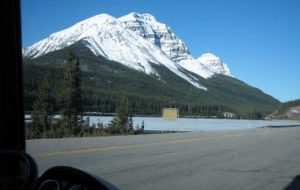RV mountain driving can have its challenges. This is the first part of a series of three dealing with some of those challenges.
The Climb: Before venturing up into the mountain range, be sure you have adequate fuel for the run. You will be burning more fuel per mile and gas stations are all but nonexistent in the mountains.
The ascent up long, steep mountain grades takes a lot of power. It places a heavy load on your engine and transmission, which can cause their temperatures to rise quickly. You must keep the engine RPM towards the high side. This includes even diesels that attain the highest torque at a fairly low engine speed. The higher speed helps cooling of the transmission and also increases the efficiency of the motor cooling package.
Accomplishing this with the transmission selector in “Drive” would require holding the throttle wide open. Otherwise, an upshift can occur. So, you must manually select a lower gear appropriate to the speed you wish to maintain and that will allow the RPM to stay high. (Using a manual selected gear with partial throttle will also reduce the climb’s fuel consumption.) How high should the engine speed be? Probably about 70% of a gas engine’s redline and 90% of the governed speed of a diesel engine.
If you stop when you reach the summit or pull over while ascending, do not stop your engine until it has cooled down from the workload. This may take several minutes. This applies to both gas and diesel.
In addition to keeping an eye on the engine and transmission temperature while making your way up the grade, observe the outside temperature. If it was quite cool at the bottom of the climb, it may be much colder at the top. Air temperature goes down as you increase elevation at a rate of about 3.5 F. per thousand feet. This is called the normal lapse rate. Steeper lapse rates can occur in unstable weather and may reach up near 6.0 F. per thousand feet.
So, if it were 50 degrees F. when you reached the mountain base and you later reached the summit of 6,000 feet, you could expect the temperature somewhere around 28 degrees F. While this will certainly help keep the running gear cooler, it may also cause the formation of ice should moisture be present. Ice can be encountered even on a bright sunshine day. Shaded areas that have remained wet from the night before or a roadside mountain spring may cause icy sections along the way. A reduced speed and extra caution is a prudent move when temperatures reach freezing or below.
Many mountain grades offer great scenic views. Just remember to keep your eyes on the task at hand and relax and enjoy the climb.


Bill Miller
If your engine overheats turn on the heater, it is a good cooling helper. Always carry antifreeze in a container ,if your engine overheats you will have a refill don't forget water .watch where you pull over, I always blow out my radiator
Simon Lodewijks
Great article, will be making my first RV trip in my recently acquired 1995 Fleetwood Flair from San Jose CA to Eureka CA. Anyone driven that route recently?
Bobby Sadler
great article!
Bobby Sadler
great article!
Terry Okeefe
It also seems the higher you go the narrower the roads get
Terry Okeefe
It also seems the higher you go the narrower the roads get